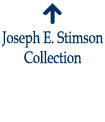|
Wyoming State Parks and the Division of Cultural Resources are hosting
a sample of the collections maintained by our agency as part of the
Western
Trails Project sponsored by IMLS
through the Colorado
Digitization Project. All of the collections available are linked
by a "trails" theme. Collections from the Wyoming State Archives,
Museum, State Archeologist, State Parks, and State Historic Preservation
Office are available. Each section has unique items, yet are all part
of the documentation of Wyoming's history.
Wyoming has
always been a passage way across the continent; from Native American
trade routes, to emigrant trails, to the building of the transcontinental
railroad, to modern interstate highways, the state continues to be a
transportation corridor for our nation. The collections provide a tangible
link to individuals and groups who crossed the landscape. Photographs,
diaries, artifacts, documents, and scrapbooks all help to build a rich
appreciation of our history.
We hope that
you enjoy this sample of our collection. If you are interested in obtaining
images or are interested in researching our entire collection, please
contact the Wyoming State Archives, 2301 Central Avenue, Barrett Building,
Cheyenne, Wyoming 82002 or call 307-777-7826. They will be able to direct
you to the appropriate section contact.
Featured
Exhibit-
Wyoming State Archives
Joseph E. Stimson
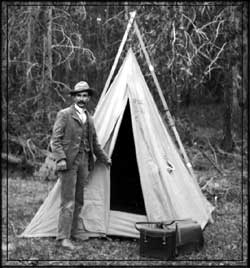
1870 - 1952
Joseph E. Stimson was born in Virginia in 1870 and
spent most of his early childhood in the southern Appalachian Mountains
of South Carolina. When he was thirteen, his father moved the family
to Pawnee City, Nebraska. Three years later Joseph left for Appleton,
Wisconsin, to work as a photographer's apprentice for his cousin, James
Stimson. While in Appleton, Joseph learned the skills of portrait photography,
details of both the collodian or wet-plate process and the new dry-plate
process. He arrived in Cheyenne, probably at the suggestion of two brothers
who worked for the Union Pacific, without a camera, a studio, or a clientele.
He bought the studio and equipment of Wyoming pioneer photographer Carl Eitner, and in July of 1889, Stimson began making portraits.
In 1901 Stimson was hired as a publicity photographer for the Union
Pacific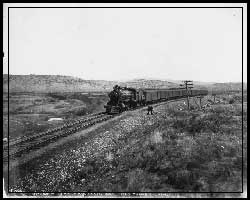 Railroad. The railroad needed photographs to help change the image of
the scandal-plagued railroad and Stimson was given free rein to photograph
anything that might draw investors to the railway. Besides the obvious
subject of the railroad itself, Stimson was to photograph natural wonders,
city scenes, farms and ranches, mining and irrigation projects, and
anything else that might bring money to the new railroad.
Railroad. The railroad needed photographs to help change the image of
the scandal-plagued railroad and Stimson was given free rein to photograph
anything that might draw investors to the railway. Besides the obvious
subject of the railroad itself, Stimson was to photograph natural wonders,
city scenes, farms and ranches, mining and irrigation projects, and
anything else that might bring money to the new railroad.
In 1903 Stimson's reputation as a scenic photographer had grown to the
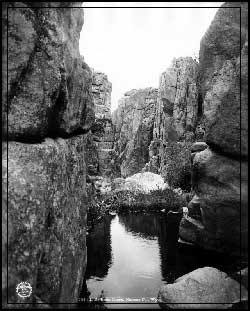 point
that he was asked by the State of Wyoming to provide five hundred Wyoming
scenes that would be displayed at the Louisiana Purchase Exposition
to be held the following year in St. Louis. The prints were to be hand
colored, a skill that Stimson often deployed before the advent of color
film. He was awarded a silver medal for his views of mining and machinery,
and two more silver medals for two other displays. By 1906, after only
ten years in scenic work, Stimson had gained national recognition as
a photographer and artist. point
that he was asked by the State of Wyoming to provide five hundred Wyoming
scenes that would be displayed at the Louisiana Purchase Exposition
to be held the following year in St. Louis. The prints were to be hand
colored, a skill that Stimson often deployed before the advent of color
film. He was awarded a silver medal for his views of mining and machinery,
and two more silver medals for two other displays. By 1906, after only
ten years in scenic work, Stimson had gained national recognition as
a photographer and artist.
In the decades that followed, Stimson continued to produce thousands
of photographs, including not only Wyoming scenes, but also Colorado,
Nebraska, Kansas, Utah, Idaho, Nevada and California. Stimson died in
1952 at the age of 82 and is buried in Cheyenne..
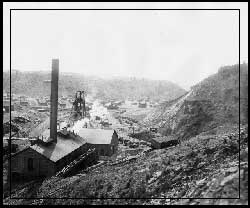 The Stimson collection was acquired by the state of Wyoming in 1953
and consist of over 7500 photographs, many of them on eight-by-ten glass-plate
negatives. The collection also has several over sized hand tinted prints,
many framed by Stimson personally. This collection is available to the
public through the Wyoming State Archives. Copyright to the Stimson
Collection is held by the Wyoming State Archives.
The Stimson collection was acquired by the state of Wyoming in 1953
and consist of over 7500 photographs, many of them on eight-by-ten glass-plate
negatives. The collection also has several over sized hand tinted prints,
many framed by Stimson personally. This collection is available to the
public through the Wyoming State Archives. Copyright to the Stimson
Collection is held by the Wyoming State Archives.
|
 |
 |















